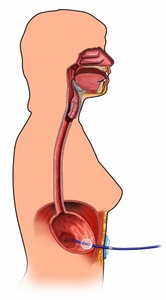Gastrostomy: permanent and temporary
Description gastrostomy
Gastrostomy – operation, in which a special tube fed into the stomach through the abdominal cavity. Gastrostomy can be done as follows::
- Эndoskopicheskaya procedure: the most popular and least invasive procedure, called percutaneous endoscopic gastrostomy (CHEG);
- Open procedure: abdominal done long cut.

Reasons for gastrostomy
Gastrostomy tube provides an alternative feeding method. The tube may also be necessary, that:
- To feed a person, which has a temporary difficulty with swallowing;
- Acid and drain fluid from the stomach.
Possible complications of gastrostomy
Before, How do gastrostomiju you need to know about possible complications, which may include:
- Infection;
- Bleeding;
- Aspiration – accidental ingress of fluid into the airway, food or foreign objects. As a result, you may encounter inhalation pneumonia;
- Damage to other organs;
- Problems, associated with anesthesia;
- Skin irritation around the tube insertion site;
- The displacement or damage to the tube;
- Diarrhea.
Factors, that may increase the risk of complications:
- Obesity and diabetes;
- Smoking, Alcohol abuse or drug use;
- The use of some drugs;
- Previous abdominal surgery;
- Advanced age.
How is gastrostomy?
Preparation for the procedure
Before gastrostomy or doctor will prescribe the following:
- Studying the history of the disease;
- Will review the medication;
- Examine physically;
- Running evaluation of swallowing ability;
- Ordered blood and urine tests;
- Held X-rays of the abdominal cavity;
- Endoscopic examination of the stomach – endoscope is a long tube with a camera on the end, which can be introduced into the throat to the stomach.
In the run-up to the procedure:
- Consult your doctor about the drugs taken. A week before surgery you may be asked to stop taking some medicines:
- Aspirin or other anti-inflammatory drugs;
- Blood thinners, such as clopidogrel (Plaviks) or warfarin;
- The night before the operation can eat a light meal. Do not eat or drink anything after midnight.
- We need to organize a trip to the procedure and back home.
Anesthesia
Used general anesthesia, which blocks any pain and support the patient during surgery in sleep.
Procedure gastrostomy
If you can not perform CHEG, doctor will gastrostomiju using open transaction. In some cases, gastrostomy may be done during other gastric surgery. The doctor makes an incision in the skin of the abdominal wall and stomach. Through the skin and into the stomach tube inserted, which is fixed in place with a seam. Then the doctor closes the incision.
Immediately after treatment
The doctor is satisfied, the tube is inserted correctly. You will be moved to the recovery room. Condition will be closely monitored.
How long will gastrostomy?
1 an hour or more.
Gastrostomy – Will it hurt?
You may have pain after surgery. In this case, the doctor will prescribe pain medication.
The average hospital stay
This procedure is performed in a hospital. Usually stay of several days. The doctor can extend the stay, If there are complications.
Care after gastrostomy
- Depending on your state, you may need to receive nutrition intravenously in the form of liquids for the first day or two after surgery or until the bowel does not work properly. Average power must begin with the reception of clear fluids, gradually moving to a normal diet;
- Keep the incision in the tube insertion site clean and dry;
- Wash your hands before touching the area of injection tube;
- Ask the doctor, when it is safe to shower, bathe, or to expose the cut by water;
- Take antibiotics. Do not stop reception, Even if you feel healthy;
- Find Out, how to look after the feeding tube. Besides, find out, how to purify. This will reduce the risk of clogging;
- Find Out, what to do, if there were serious complications (eg, Offset tube or flow).
- Be sure to follow your doctor's instructions.
Contact your doctor after gastrostomy
After returning home, you need to see a doctor, If the following symptoms:
- Signs of infection, including fever and chills;
- Redness, edema, increased pain, bleeding or any discharge from the incision around the tube;
- Problems with the tube, including, if it shifts, clogs (The offset is the most common problem during the first two weeks after the procedure);
- Diversion of food around the tube insertion site;
- Cough, breathlessness, chest pain;
- Nausea, vomiting, constipation, abdominal distention;
- The inability to release gas or stool;
- Severe abdominal pain.
